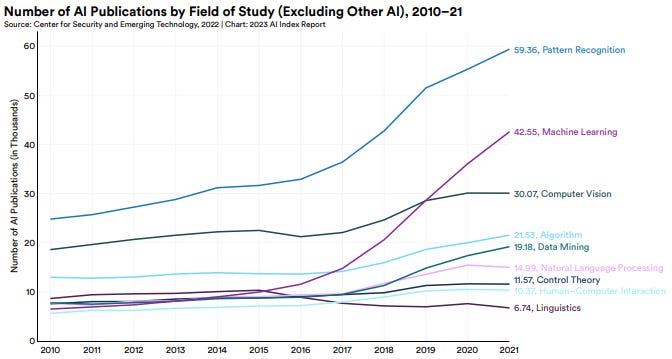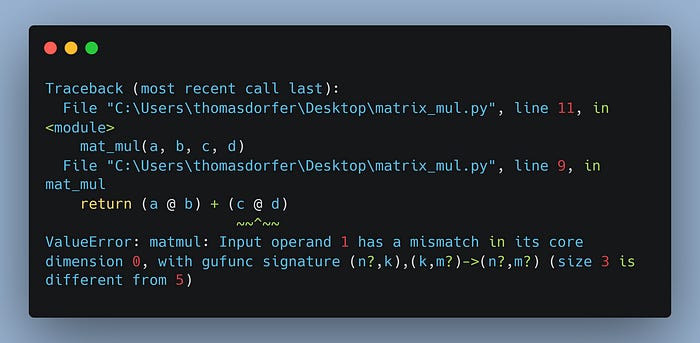Stanford's AI Index Report 2023
Tracking the progress, adoption, and impact of artificial intelligence. Also in this edition: Enriched tracebacks provide a better debugging experience in Python 3.11
Welcome to the first edition of Tech Talk with Thomas - a newsletter for insights and updates on the latest trends in data science, technology, and AI. I’m Thomas, your host, and I'm excited to share my thoughts with you on the latest happenings in the tech world.
This edition contains:
👋 Brief introduction of yours truly
📋 Stanford’s AI Index Report 2023
🐍 Python’s enriched tracebacks
I’m Thomas, Your Host.
Hey there, tech enthusiasts! I’m Thomas and I’m excited to be your host for this brand-new newsletter. With over six years of experience in research and industry, I’m thrilled to share my thoughts and perspectives with you and cater to you the latest trends in the world of data science, technology, and AI!
My journey into tech was not a conventional one. I didn’t study computer science, interned at Google, and was later hired as an FTE. Instead, I started out by studying neuroscience as I had (and still have!) a strong interest in understanding how our brain works and what goes wrong when we get sick. After obtaining my master’s degree, I ended up doing research in an area called neurofeedback and, due to the enormous data sets I had to deal with, quickly realized the need for advanced statistics and data-driven solutions. This was essentially my introduction to data science and machine learning, and the rest is history.
After spending a few years in research, I decided to make the switch to industry - a move primarily motivated by the desire to work on more practical, real-world problems, thus creating more tangible value and a more direct impact on customers. And so I ended up spending two years in the biotech industry, working mainly on protein prediction tasks, before eventually joining Microsoft as a Data & Applied Scientist in 2021.
OK, enough about me. After all, you’re here for Tech Talk with Thomas, and not Tech Talk with Thomas. So let’s get into it!
Stanford’s AI Index Report 2023
Earlier this week, the sixth edition of the AI Index Report was released. The report, produced annually by the Stanford Institute for Human-Centered Artificial Intelligence (HAI), provides a comprehensive overview of the current state of AI research, development, and deployment worldwide. It covers a wide range of topics such as research output, technical performance, commercial applications, and societal impact, including data and analysis on education, diversity in the AI workforce, government policy, and public perception of AI.
For instance, the number of AI publications globally more than doubled from around 200,000 in 2010 to almost 500,000 in 2021.
Regarding the specific fields of study, the number of machine learning papers quadrupled in the last decade, while pattern recognition papers roughly doubled.
Here are the report’s top 10 findings:
Academia released the most significant machine learning models up until 2014. Since then, industry has taken over.
While AI continues to achieve SOTA results, YOY improvements on many benchmarks continue to be marginal. Also, the speed at which benchmark saturation is being reached is increasing.
AI is both helpful and harmful for the environment. While AI systems have serious environmental impact, reinforcement learning models can be used to optimize energy usage.
AI is rapidly accelerating scientific progress and in 2022 was used to aid hydrogen fusion, improve the efficiency of matrix multiplication, and generate new antibodies.
The number of AI incidents and controversies has increased 26 times since 2012.
Across every sector in the US, the number of AI-related job postings has increased on average from 1.7% in 2021 to 1.9% in 2022.
Global AI private investment was $91.9 billion in 2022, which represented a 26.7% decrease since 2021. Still, during the last decade, AI investment has significantly increased.
The proportion of companies adopting AI in 2022 has more than doubled since 2017, though it has plateaued in recent years between 50% and 60%. Organizations that have adopted AI report realizing meaningful cost decreases and revenue increases.
The legislative records of 127 countries show that the number of bills containing “artificial intelligence” that were passed into law grew from just 1 in 2016 to 37 in 2022.
78% of Chinese survey respondents agreed with the statement that products and services using AI have more benefits than drawbacks (Saudi Arabia: 76%, India: 71%, USA: 35%).
You can download and read the full report here.
Enriched Tracebacks in Python 3.11
If you are - like me - coding a lot in Python, you’ll enjoy this part. Its latest version, Python 3.11, comes with a new feature that makes the developer life a hell of a lot easier. Specifically, when encountering an error, the printed traceback will not only point to the line where the error occurred, but will also highlight the exact expression that caused it.
In the example above, I’m performing some simple matrix operations on four matrices. However, matrices c and d don’t have the same inner dimensions and as a result, we get an error. Notice how the interpreter pinpoints directly to the expression that caused the error: c @ d. These location-enriched tracebacks can be a huge efficiency boost when it comes to bug hunts and will certainly enhance a developer’s debugging experience.
Haven’t tried it out yet? All you have to do is upgrade your Python version to >= 3.11 and gone are the days of chasing elusive bugs until the wee morning hours.
That’s all for today folks. Hope you enjoyed this edition of Tech Talk with Thomas - until next time!






